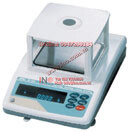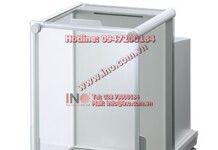|
Model 7270 – Overview
|
The model 7270 sets a new standard for general-purpose DSP lock-in amplifiers. We've taken advantage of the developments in technology since the first DSP lock-in amplifiers were introduced in the early 1990’s to update the core design, but made sure that we’ve included all the best features of our model 7265 and 7280 instruments. What’s more, the new architecture has allowed us to offer even better specifications in an instrument that is physically much more compact than older designs. The result is a lock-in amplifier of outstanding performance that is easy to use and suitable for all measurements over a frequency range extending from 1 mHz to 250 kHz.
Versatility
In common with other models in our range, the 7270 offers much more than just dual phase lock-in detection at the reference frequency of an applied signal. We’ve included features unique to SIGNAL RECOVERY instruments such as dual reference and dual harmonic detection, which allow signals at two different frequencies to be measured simultaneously. The spectral display mode shows the power spectral density of the input signal, making it easy to avoid interfering signals when selecting a reference frequency. It is now even possible to perform tandem demodulation. In this mode an amplitude-modulated signal at a (high) “carrier” frequency is first demodulated at that frequency. The resulting in-phase output, at short time constant settings, is a signal at the modulating frequency which is then passed forward for detection by a second set of demodulators running at the same modulating frequency. Such detection techniques, which can be used in pump-probe measurements, have until now required two separate instruments with an analog connection between them.
Fast Data Processing
The main ADC sampling rate and the rate at which the analog signal outputs are updated is 1 MSa/s, giving excellent performance when used at short output filter time constant settings, such as in scanned probe measurements. But we’ve also increased the maximum rate at which data can be stored to the internal curve buffer to 1 μs per point, allowing for the first time direct capture of instrument outputs when using these short time constants. The buffer length has also been increased to 100,000 sets of points, giving recording times of 100 ms at the fastest sampling rates. What’s more, in the fast capture mode the length does not need to be divided by the number of outputs being stored, making it possible, for example, to store the full 100,000 points of X, Y and auxiliary ADC1 values at the same time.
Remote Control
The built-in RS232, USB and Ethernet connections allow full operation from a controlling computer. We offer a comprehensive software package, Acquire, that can operate the instrument via any of these interfaces and makes it easy to set up and run complex experiments, such as frequency response measurements, as well as allowing remote control of every instrument function. Users who wish to do their own programming can use our ActiveX control and toolkit (SRInstComms), or free LabVIEW driver, to simplify the task.
See what you’ve been missing…
In summary, if you’re looking for a general purpose lock-in to work in the range 1 mHz to 250 kHz then you need look no further – you’ve found it in the SIGNAL RECOVERY model 7270.
- 1 mHz to 250 kHz operating frequency range
- 1.0 MHz main ADC sampling rate
- 10 µs to 100 ks output filter time constants
- Dual Reference, Dual Harmonic and Virtual Reference operating Modes
- Internal data buffer for recording instrument outputs at rates down to 1 µs per point
- USB, RS232, and Ethernet computer interfaces
The model 7270 sets a new standard for general-purpose DSP lock-in amplifiers.
Model 7270 Specifications
| Signal Channel | |
| Voltage Input | |
| Modes | A only, -B only or Differential (A-B) |
| Freq. Response | 1 mHz < F < 250 kHz |
| Full-scale Sensitivity | 2 nV to 1 V in a 1-2-5 sequence (e.g. 2 nV, 5 nV, 10 nV, 20 nV, etc.) |
| Z – FET | 10 MΩ // 25 pF, AC or DC coupled |
| Z – Bipolar | 10 kΩ // 25 pF, input must be DC coupled |
| Max safe input | ±12.0 V |
| Vin Noise – FET | 5 nV/√Hz @ 1 kHz |
| Vin Noise – Bipolar | 2 nV/√Hz @ 1 kHz |
| C.M.R.R. | > 100 dB @ 1 kHz degrading by > 6 dB/octave with increasing frequency |
| Gain Accuracy | ±0.5% typ, ±1.0% max |
| Distortion | -90 dB THD (60 dB AC gain, 1 kHz) |
| Current Input | |
| Mode | Low Noise (10E8 V/A) or Wide Bandwidth (10E6 V/A) |
| Full-scale Sensitivity | |
| Low Noise | 2 fA to 10 nA in a 1-2-5 sequence |
| Wide Bandwidth | 2 fA to 1 µA in a 1-2-5 sequence |
| Frequency Response (-3 dB): | |
| Low Noise | 1 mHz < F < 500 Hz minimum |
| Wide Bandwidth | 1 mHz < F < 50 kHz minimum |
| Impedance | |
| Low Noise | < 2.5 kΩ @ 100 Hz |
| Wide Bandwidth | < 250 Ω @ 1 kHz |
| Noise | |
| Low Noise | 13 fA/√Hz @ 500 Hz |
| Wide Bandwidth | 130 fA/√Hz @ 1 kHz |
| Gain Accuracy | ±2.0% typ, midband |
| Max. Dynamic Reserve | > 100 dB |
| Grounding | BNC shield can be grounded or floated via 1 kΩ to ground |
| Signal Monitor Amplitude | ±1 V FS |
| Output Impedance | 1 kΩ |
| Reference Channel | |
| Reference Input | |
| Frequency Range | 1 mHz to 250 kHz |
| Analog Input (front panel) | |
| Impedance | 1 MΩ // 30 pF |
| Sinusoidal Input Level | 1.0 V rms* |
| Frequency Range | 0.5 Hz to 250 kHz |
| Squarewave Input Level | 250 mV rms |
| Frequency Range | 2 Hz to 250 kHz |
| Reference Channel | |
| Phase Set Resolution | 0.001° increments |
| Phase Noise at 100 ms TC, 12 dB/octave slope: | |
| Internal Reference | < 0.0001° rms |
| External Reference | < 0.01° rms @ 1 kHz |
| Orthogonality | 90° ± 0.0001° |
| Acquisition Time | |
| Internal Reference | instantaneous |
| External Reference | 2 cycles + 1 s |
| Demodulator and Output Processing | |
| Harmonic Rejection | -90 dB |
| Output Filters | |
| Time Constant | 10 µs to 100 ks in a 1-2-5 sequence |
| Slope (roll-off): | |
| TC < 5 ms | 6 or 12 dB/octave |
| TC > 5 ms | 6, 12, 18 or 24 dB/octave |
| Synchronous Filter | Available for F < 20 Hz |
| Offset | Auto and Manual on X and/or Y: ±300% full-scale |
| Phase Measurement Resolution | < 0.01º |
| Oscillator – General | |
| Freq. Range | 1 mHz to 250 kHz |
| Setting Resolution | 1 mHz |
| Absolute Accuracy | ± 50 ppm |
| Amplitude Range | 1 µV to 5 V |
| Max. Setting Resolution | 1 µV |
| Output Impedance | 50 Ω |
| Sweep | |
| Frequency Sweep | |
| Output Range | 1 mHz to 250 kHz |
| Law | Linear or Logarithmic |
| Step Rate | 1 kHz maximum (1 ms/step) |
| Amplitude Sweep | |
| Output Range | 0.000 to 1.000 V rms |
| Law | Linear |
| Step Rate | 20 Hz maximum (50 ms/step) |
| Oscillator Output | |
| Amplitude | |
| Accuracy | ±0.2% typ |
| Stability | 50 ppm/ºC |
| Distortion (THD) | -80 dB @ 1 kHz and 100 mV rms |
| Data Storage Buffer | |
| Size | 100,000 data points |
| Max. Storage Rate | |
| Fast Mode | up to 1 MHz (X1, Y1, X2, Y2, ADC1, Demod I/P 1, Demod I/P 2) |
| Normal Mode | 1 kHz |
| User Settings | |
| Up to 8 complete instrument settings can be saved or recalled at will from non-volatile memory | |
| Interfaces | |
| USB 2.0, Ethernet, and RS232 allow complete control of instrument settings, and data readout. | |
| General | |
| Power Requirements | |
| Voltage | 110/120/220/240 VAC |
| Frequency | 50/60 Hz |
| Power | 40 VA max |
| Dimensions | |
| Width | 15½" (390 mm) |
| Depth | 7¼" (185 mm) |
| Height | |
| With feet | 7¼" (185 mm) |
| Without feet | 6½" (170 mm) |
| Weight | 12.8 lb (5.8 kg) |
| Specifications subject to change without notice |




















